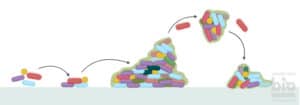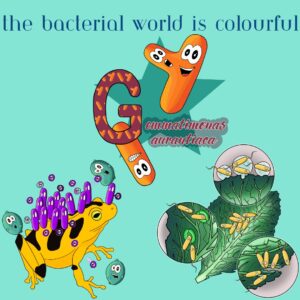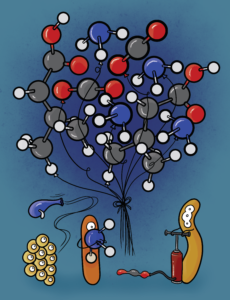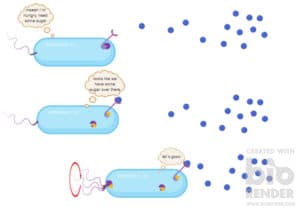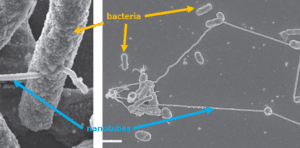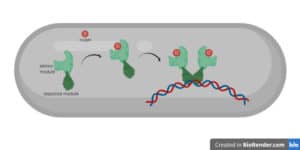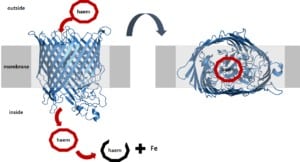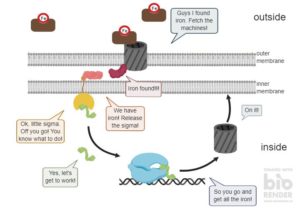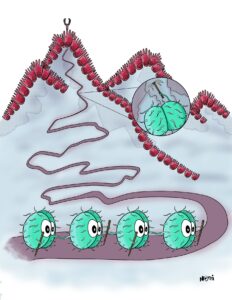Bacteria seem to be very lost in their environment.
They don’t have eyes to see what is going on.
Neither do they have ears to hear a foe approaching.
And yet they seem to know exactly what is happening around them.
How is that possible?
In other articles, we already looked at different mechanisms of how bacteria sense their environment. And we learned about various ways bacteria use to know what is going on around them.
Here, we will look at another one of these mechanisms. A mechanism in which bacteria destroy proteins to understand the environment and adapt to it.
But before we can look at why bacteria destroy proteins, we first need to understand how bacteria produce proteins.
Bacteria need proteins to produce proteins
Every living cell, like a bacterial cell or a human cell, contains DNA. And the DNA contains many different sections, which are genes. These genes are the templates for ALL proteins that a cell can produce.
A cellular machine called the polymerase (bright blue in the figure below) recognizes the start of a gene (yellow), before it transcribes this gene into a string of mRNA (grey). Next, a ribosome reads the mRNA fragment and translates it into a protein (yellow).
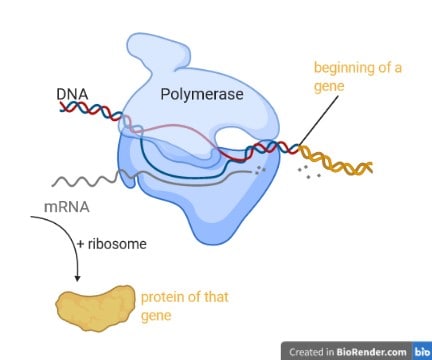
This is how every living cell produces proteins from DNA.
Now, we will focus on the first step: when the polymerase recognizes the start of a gene.
Bacteria need proteins to regulate protein production
When you think about it, bacteria do not always need all genes and all proteins. Just as you don’t need an umbrella when it is sunny outside, but it is always good to keep it handy. Similarly, bacteria have heaps of genes on that long string of DNA and they need some of them only under certain circumstances.
For this, all living cells have regulators. These regulators make sure that the polymerase only produces mRNA from genes that are required at a specific time point.
And these regulators come in two forms: activators and repressors.
Activators activate genes
Sometimes, the polymerase cannot recognize a specific gene on its own. This is when the polymerase needs an activator (green).
An activator is a protein that binds to a specific gene only when needed. This attracts the polymerase to this gene so that it produces mRNA from that gene. Like that, an activator ensures that bacteria only produce certain proteins when needed.
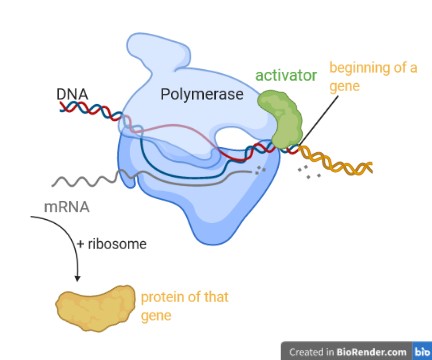
This means something else needs to activate the activator at a specific time point. And while some activators are activated by specific systems as explained in How bacteria sense their environment, sometimes protein-destroying systems are involved. More about that below.
Repressors deactivate genes
Repressors (dark blue) do exactly the opposite of activators. These proteins bind specific genes right at the start. This blocks the polymerase from binding the start of that gene and from producing mRNA.
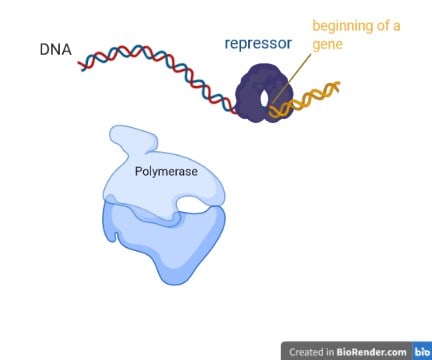
But when the bacterium needs a specific protein, the polymerase has to recognize and bind that specific gene. At that point, the bacterium has to get rid of the repressor.
So, let’s have a look at how bacteria gain access to genes that need activators or are blocked by repressors.
Bacteria destroy proteins to understand the environment
The environment constantly changes for a bacterium. So, all the time, a bacterium needs to produce certain proteins to handle these new situations. Just as you take your umbrella when it is raining suddenly.
This is when the bacterium needs the polymerase to recognize a specific gene to make mRNA from it.
To get rid of a repressor or to activate an activator when needed, bacteria came up with a simple mechanism: protein destruction.
Yes, to produce proteins, sometimes bacteria destroy proteins.
Proteins that destroy proteins are called proteases and these work like molecular scissors. Proteases cut proteins in at least one specific location. This makes the protein fall apart and become kaput.
When do bacteria destroy proteins?
Different bacteria developed various mechanisms when to destroy specific proteins. And researchers start to understand more and more about this way of regulation.
So, let’s have a look at a few cool examples of bacteria destroying proteins.
Radiation leads to protein destruction and survival
For example, the fascinating bacterium Deinococcus deserti has genes to cope with radiation and desiccation. However, the bacterium does not need to produce these proteins when there is no radiation or desiccation.
Under these circumstances, the repressor D (dark blue in the figure below) blocks these genes and makes sure the polymerase cannot recognize them.
But as soon as the bacterium is hit with radiation (lightning), the radiation activates the protease M (red). This protease can now bind the repressor D and destroy it. Now, that the repressor does not block the radiation genes anymore, the polymerase can recognize the genes and produce mRNA from them. Now, the ribosome produces proteins (yellow) that cope with the radiation.
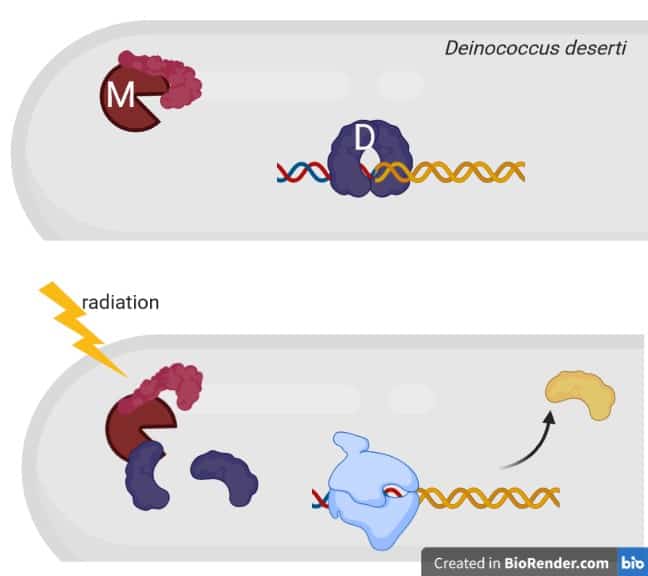
And this is how the bacterium Deinococcus deserti destroys proteins to survive. And yes, this bacterium has the superpowers to withstand radiation and desiccation like no other bacterium.
Antibiotics lead to protein destruction and resistance
In another example, Staphylococcus aureus has a similar mechanism to cope with antibiotics and become resistant.
In the membrane of this bacterium sits the protease R (red) that is generally inactive. However, when the bacterium meets antibiotics (green molecules), the antibiotics change R.
Now, the protease falls into the inside of the bacterium and destroys its target protein. This is the repressor I (dark blue), which sits and blocks a certain gene. After protease R destroyed repressor I, this gene is unblocked and the bacterium produces a protein (yellow) that cleaves the antibiotic.
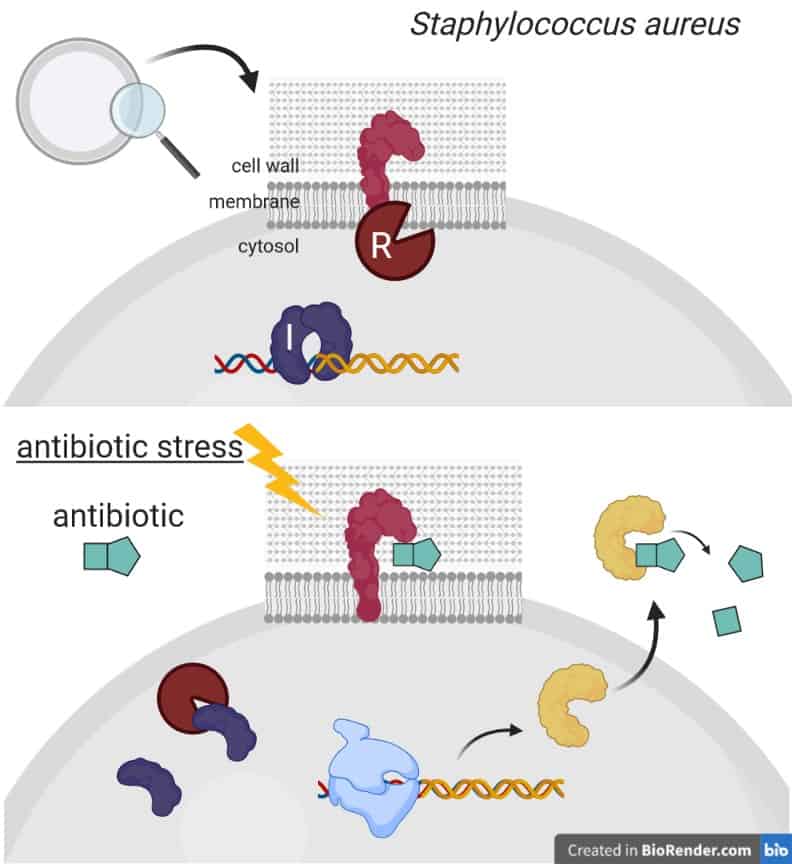
And this is how Staphylococcus aureus becomes resistant to antibiotics by destroying proteins.
Heat leads to protein destruction and survival
But bacteria do not only destroy repressors. They also use a similar mechanism to activate their activators.
Generally, to keep an activator inactive, another protein is involved. This is the so-called anti-activator since it captures the activator and inhibits it from functioning. So, for the activator to become active and to bind its specific gene, the anti-activator needs to go. And this is exactly what bacteria do.
For example, in the soil bacterium Bacillus subtilis, the anti-activator Y (dark blue) captures the activator S (green). Plus, Y brings S to the cellular garbage machine (purple) to destroy this protein.
However, as soon as it is getting too hot for the bacterium, Y becomes unstable. So unstable, that it cannot hold S anymore. This means S gets freed, binds its favorite genes and leads the polymerase to them. Now, the bacterium produces proteins (yellow) that help the bacterium to cope with the damage from the heat.
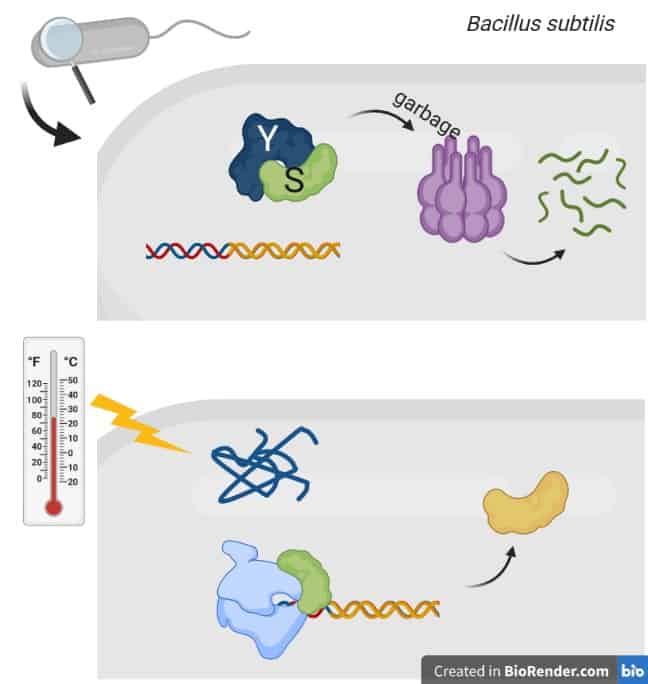
And this is how Bacillus subtilis destroys proteins to cope with heat.
Destroying proteins means bacteria can survive
Here we explored three different ways of how bacteria destroy proteins for their own benefit. Interestingly, the benefit always handles the incoming signal which is often a sign of stress.
Like in Deinococcus deserti, radiation activates protein destruction that leads to protein production. And these new proteins now handle the damage after the radiation attack.
Or in Staphylococcus aureus; antibiotics activate a specific protease that destroys a repressor. Now, the produced proteins are meant to destroy the harmful antibiotics.
So by closing these circles, bacteria found efficient ways of how to read their environment and adapt to it.
Interestingly, most bacteria seem to use similar mechanisms. This means, the better we understand the way most bacteria work, the better chances we have to fight the nasty ones. So we need to keep researching the good bacteria, to understand the bad guys too!

